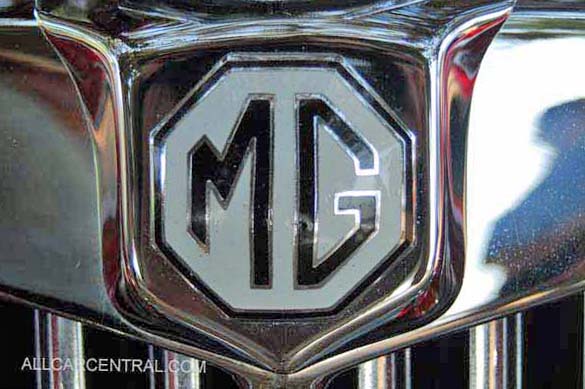
MG - Morris and Morris Garage
By Geoff Wheatley
Most people who own a MG will know that the MG badge on the front of their car represents "Morris Garage" however how many of such owners are aware what "Morris Garage" was and why it existed. Billy Morris who started the Morris motor company in a garden shed in the rear of his parents home, was, by any standards a shrewd business man who saw the development of the motor vehicle as a mass market product, not simply a toy for the rich and famous. He left school at the age of twelve and was apprenticed to a bicycle repair shop in Oxford, England. Bicycles were the most popular means of independent transport at that time, both in Europe and America. They were as popular as the computer is in today's world.
When Morris finished his apprenticeship at the age of sixteen he asked the owner of the business for a twenty-five cent raise. He was refused so he left and started his own business building and selling bicycles at home. Through some arrangement that was never made clear, he used the front room of his parent's house as his sales area. And they moved to the upstairs floor... within three years he had moved to other premises and was also producing motorcycles, employing 26 men by the time he reached the age twenty one. He was a great admirer of Henry Ford and visited Ford early in his career. They became good friends, a friendship that lasted for many decades.
Ford introduced him to several American suppliers; this gave Morris a distinct advantage over his UK competitors. In return he agreed to feature selected American vehicles in his new showroom being built in central Oxford. He also took Ford's idea of assembly line production and adopted it to meet British requirements. Ford was the first manufacturer to deal directly with the public rather than through agents. This gave the manufacturer flexibility on production and more important control over the price of the car. Morris liked this idea and on returning to England he ended all existing contracts with agents and started his own distribution center called "Morris Garage". In reality it was his original new building with a different name and more show space. He also sold other manufacturers cars including certain quality American products...
MG J2 1933
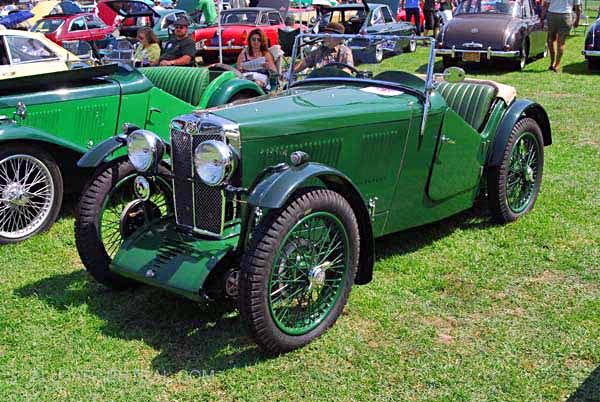
I recall as a small boy of looking into the windows of this establishment standing on the door step which consisted of a large stone slab about ten feet by six with the picture of an Ox crossing a Ford imprinted on the top surface in red and blue. This is the city of Oxford coat of arms taken from a Saxon engraving of around 850 AD.
The challenge to any small boy was to jump from the head of the ox to the tip of his tail in one go. When the showrooms were closed in 1970 this famous front step was thrown on the local scrap heap along with many other artifacts that some of us give their life saving to have today. By chance a local scrap merchant saw the step and despite the fact that it was broken during the demolition, purchased it for about twenty U.S. dollars then presented it to the MG owners club who it had repaired. It now greets MG owners at their club headquarters.
The First World War created a demand for motor vehicles and manufacturers like Morris, and of course Ford, who now had a UK factory. When the war ended Morris had built a large production plant outside of Oxford in the village of Crowley to support his war effort. The same applied to Ford who also expanded his U.S production plant.
However, both Ford and Morris almost lost everything due to an unforeseen situation. The general feeling by the allied governments was that the war would not end until 1919 or even 1920. In America the forecast was even longer after economic evaluation was made of the exhausted state of both Britain and France. The allied manufacturing plants were encouraged to continue peak production through 1918 and into 1919. When Germany collapsed in the fall of 1918 and the war came to a sudden end Morris and Ford had at least six months production waiting to be shipped to the war zones. Governments in those days did not pay in advance. It was considered your duty to provide credit to the war effort.
The Ford Company shipped most of their war production back to the Ford plants in the U.S. and somehow managed to absorb the loss. However Henry Ford directed his UK operation to send about 15% of their war production to the White Russians fighting the Bolshevik's in Russia. It was a gift from a devoted capitalist. However, the vast majority of these vehicles never saw action as they were not designed for the Russian climate and simply froze before they could even be unloaded. Morris was not that political and sold his vehicles at production cost to anyone who had the money to buy, and survived. But others went to the wall. The war boom was over and companies who had mortgaged their future in war production went bust.
Until 1925 the "Morris Garage" operation carried a number of other brand names sold on a commission basis. A visit to the showrooms would enable you to view the latest American Hudson Super Six or its less expensive Hudson Essex. You might also find a couple of Dodge vehicles in company with a British Hillman, Sunbeam or Daimler.
Morris Cowley 1929
Photo Submitted by
Rick Feibusch, 2012
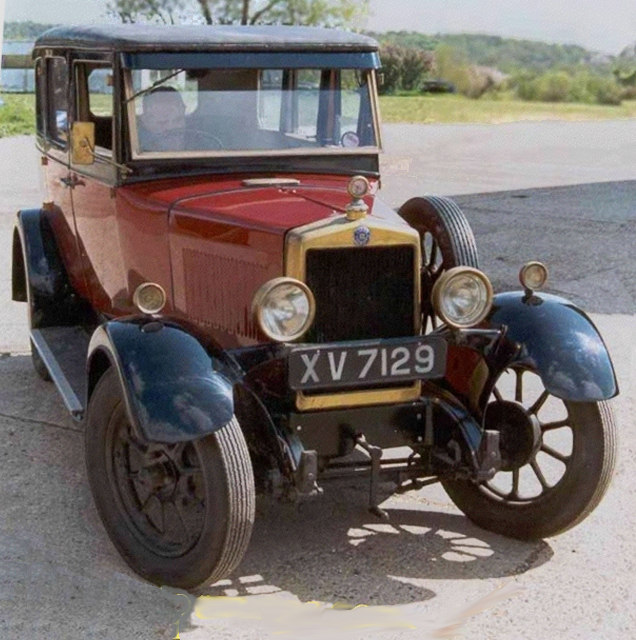
The ever-popular Bull Nose Morris and the Morris Oxford would be on show in company with a luxury Wolseley.
The latter was being one of the manufacturers who went under in 1919. Morris purchased the company in auction, an action that became the basis of intense rivalry between Herbert Austin and Billy Morris that continued until Austin passed away in 1968. Herbert Austin had been the general manager of the new Wolseley carriage company when it started in 1899. He considered it his personal creation almost like a first-born child. In 1906 he resigned his position as general manager to start his own company, which in time would become the competitive rival to the Morris Empire especially in the popular small car market that boomed in Britain after the First World War.
Austin never forgave Morris for buying Wolsleley before he could raise the money to bid for the company and often referred to Morris as "That Back Street Upstart".. I don't think Morris was ever upset by this as his wealth simply grew year by year and he continued to buy companies that could supply his production needs.
Like Ford he was one of the few manufacturers who produced his own engines, bodies and wheels. Most of the other car companies purchased from independent suppliers and consequently were at the mercy of the market when sales increased or declined.
1n 1926 a new direction was adopted at "Morris Garages", the new general manager Cecil Kimber who was certainly the God Father if not the Father of the M.G sports car, persuaded Morris to concentrate on selling only Morris products, the profit was better and it established the location as the show case of the Morris Empire. Until Kimber joined the Morris Company Billy had his main office on the second floor of the show rooms and was available to discuss and converse with his customers. Never a born salesman... Morris tended to be serious and his interests were practical.
In his youth he had wanted to study medicine and only started his bicycle business to raise enough money to attend medical school. His lack of formal education blocked this desire; instead he was destined to become one of the wealthiest men in the world giving millions of dollars to both Oxford University and its world famous hospital.
He built the first woman's college in Oxford named after his wife, Kathleen. Followed by Nuffield College, the first international establishment of the university. I had the pleasure of attending Nuffield College and even met Morris at a college garden party a couple of years before he died in 1963. Needless to say I was impressed with the man. At that time his total wealth was estimated at around eight billion 1960 dollars. Sad to say the government took most of it in death duties.
He left no children and gave at least half of his fortune away. Kimber his new general manager must have been a good choice as within eighteen months Morris had vacated his upstairs office and moved to the production plant at Crowley.
He installed a new office and a small apartment where he spent most of his working and private life. (This may be why there were no heirs to the Morris fortune as his wife preferred to reside at their county home at "Nuffield", the name that Morris chose when he became a "Lord of the Realm". Kathleen entertained quite lavishly with weekend parties while Morris played around with his toys back at the factory, usually making a nuisance of himself with the production staff by changing designs or stopping production to inspect a certain procedure. In short a micro manager par excellence!
The Morris Garage complex consisted of a main showroom with various minor display centers in and around Oxfordshire. It also had its own workshop and eventually a crew of about ten workers. In the early days Kimber had to borrow workers from Cowley when he wanted to put together a special car for a special customer.
This was seen by Crowley as an infringement on their domain and it was only because Kimber had a sound relationship with Morris that this type of backroom construction ever took place. Old number one, the first MG ever made was produced under these circumstances with three men borrowed from Cowley.
To be honest they were hijacked from the Morris Works on the grounds that the "Boss", wanted Kimber to create a car that could be entered in a London to Lands End National Event to obtain publicity. The fact that Kimber actually won this rally with this car was a surprise to all concerned, and I suspect even Kimber himself! Morris garages were one of the largest advertisers in the U.K. In 1921 they spent in excess of $30,000 on advertising which resulted in a turnover in sales in excess of two million 1922 dollars.
Morris took a leaf out of his mentor Henry Ford who also spent large sums on promotional advertising. Morris believed in advertising and made several short promotional films to advertise his cars long before any competitor even thought of this promotional activity. I have one that was made in the 1920's..(Silent of course).
MG VA 1937
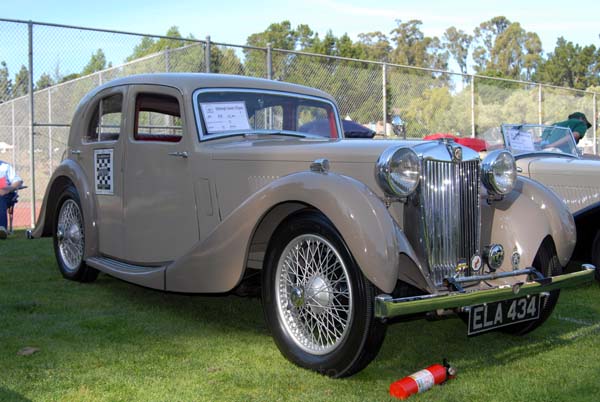
The competition saw sales as simply a display operation. Put the cars in the showroom and the public would do the rest. Morris believed that you had to get them into the showroom first and did his with advertisements and any other promotional activity that he could devise. When Morris started his humble cycle shop the first thing he did was build a bicycle and enter it in the national races that were popular around the turn of the 1900's.
He became a regular competitor and even managed to win a couple of national awards. The same policy applied when he started to make motor cycles he became a competitive rider and even supported a three man team riding Morris Motor Cycles with his name plastered all over the crew. Kimber was also competitive; he was an active rally driver and certainly made a name for himself in hill climbing events winning the British Cup no less than three times in various vehicles. All this despite the fact that he was disabled due to a motor cycle accident in his youth.
In today's terms they were both excellent marketing people selling an equally excellent product. When the market was booming Morris reduced his prices while his competitors increased theirs to make a quick buck. When sales were low Morris maintained his work force and stockpiled his vehicles while others laid off workers and reduced production. If things got really bad as they did in 1924/25 when there were more cars than buyers Morris sold his vehicles at cost plus 5% and turned over his production every three months.
This short depression may have been one of the deciding factors in dropping other vehicles sold in his showrooms on commission and concentrating on only Morris vehicles. We do know that as early as December 1923 the "ISSIS" Newspaper in Oxford featured an advertisement for the Super Sports Morris and the letters MG were featured in the advertisement for the first time. A similar version was featured in the Morris Owner in May 1924. These are the first recorded use of the now famous octagon and the letters M.G.
By 1926 the words MG Sports was being promoted by Morris Garages for a number of vehicles that were made in various small workshops under Kimber's direction. Totally separate from the Main Morris Factories. The fact that Kimber had won a national award in a Morris MG certainly enhanced the image and this rather special car still exists today in the Heritage Center in Britain.
It came to America a few years ago and was quite an attraction.
By 1928 the demand for MG sports cars had reached a point where a permanent factory was required and the small village of Abingdon was chosen mainly because in the prewar days there had been a tanning factory in Abingdon that was now vacant and, as was usually the case with Billy Morris, the price was right. Abingdon however was not in Oxfordshire; it was in the adjacent county of Berkshire. The final decision to move out of Oxford may well have been influenced by certain Local Government restrictions applied in co-operation with the University of Oxford.
The University Governors were becoming concerned with the damage being done to the University buildings some over a thousand years old, by the commercial trucks that thundering down the 15th century streets often damaging these fragile structures.
In cooperation with the County Government a financial levy was applied to all commercial operations within the City Boundaries which covered an area of ten sq miles from the city center. This virtually stopped any industrial activity within the city and forced several small manufacturers to make a hasty retreat to more friendly locations. The four small MG production centers must have felt the impact of this financial burden and obviously looked for another location.
Abingdon was chosen located just outside of the Oxfordshire County Boundary and therefore except from any financial levy. What's more the Abingdon Council welcomed such industry and this certainly made it easy to relocate the MG production in 1928. A total of forty five men and three women were employed at the new MG Company by December 1929. Most were acquired from Morris Motors Cowley despite protest from the Cowley management.
MG SA saloon 1936
Photo Submitted by
Rick Feibusch, 2012
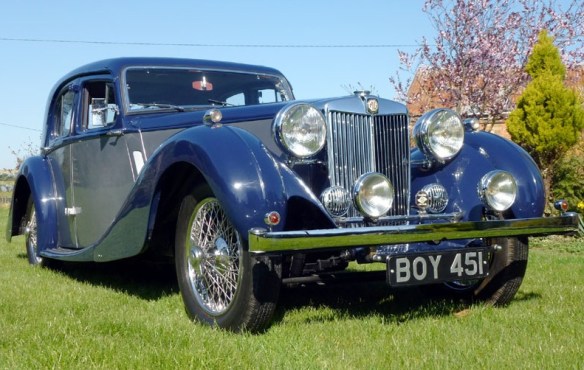
My father at the age of 25 being one of them. A few years later I joined the Wheatley family in Abingdon although to be honest I can't recall the actual moment or any MG's being around at that time! Returning to the damage concern by the Governors of the University, around 1938 the City of Oxford attempted to reduce the effect of traffic vibration by fitting rubber road blocks in the streets of the city. I remember at the tender age of around five or six this Mammoth Operation of tearing up the road surface that had been around for at least 150 years, and replacing it with rubber blocks. The end result was interesting. Yes the blocks did stop some of the vibration but when it rained the vehicles lost traction as rubber met rubber on a wet surface....need I say more!
In 1948 the whole system was removed and a bypass was built to redirect trucks around the city. As a result the old buildings are still standing... For the first two years of operation the MG factory produced an average of about twenty five cars a week so any additional production space was utilized by the Wolseley Team. My father recalls that about a dozen men worked on these vehicles, usually about two weeks in every month. While the MG was a cheap vehicle selling for one hundred and ten pounds. The Wolseley cost twice that figure.
However, the depression had started to hit Britain so demand was limited. Morris Motors introduced a hundred pound family car in 1931 and Austin the principle competitor the ninety nine pound Austin Seven the next year. Ford UK featured ninety pounds, two door sedan, but if you wanted a spare wheel speedometer and widescreen wipers it was one hundred and three pounds.
As the average wage in the UK at that time was two pounds for a sixty hour week, it took a long time to obtain a car. Billy Morris offered his workers a purchase plan that enabled them to buy at just over cost and have payments deducted from their weekly pay packet. He said this was the best form of advertising you could get as the workers were happy and the name Morris was being promoted every day on the highway. I know that the first car my father owned was purchased this way and I had the task of cleaning it every weekend to get my allowance. Needless to say I wish I had it now!
In 1936 Morris decided that he would sell MG to the Morris Motor Company of which he was the Chairman. Obviously it was a tax move especially as MG had never made a profit since in moved to Abingdon. Sales were reasonable but as each model was virtually hand made often to the requirements of the customer, they were not money makers when compared with the other Morris vehicles that sold in their hundreds.
This introduced a complete change of policy at Abingdon. Morris Motors were now in control of the MG Company and the first thing they did was to lay off half the work staff and stop any individual vehicles being made to/for customer's specification. All the component parts now had to be produced by Morris motors including the engines, no more fancy high compression units, no design office, no factory racing teams that cost money every time that hit the race track. Kimber was demoted from general manager to production manager and when he protested was threatened with dismissal.
Billy Morris conveniently took a world cruise whilst all this was going on so Kimber was alone and had to accept the situation. The 1936 MGTA was the first product under this system with an engine originally produced for a Morris family sedan. This power unit was designed to cruise along the highway at 50 miles an hour not raced on dirt tracks or cross country events as was the usual purpose of the original MGs..
MG TA Tickford 1938
Photo Submitted by
Rick Feibusch, 2012
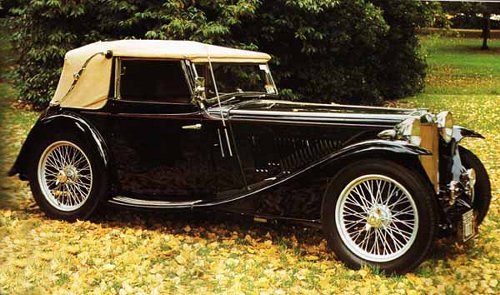
The front fenders now considered the hall mark of the MG T series came off the successful Morris commercial van. No more fancy wood or leather seats unless the customer wanted to pay extra for such things and some did, only to find that the performance of this new MG was, to say the least, disappointing. The engines usually gave up after being driven at speeds associated with the MG marquee. Gearboxes designated when attempting sporting contests like hill climbs or road rally's.
In short MG lost its hold on the market in a matter of months and in consequence lost even more money that before the take over. In order to try and keep the production lines going Kimber in cooperation with the design team at Morris Motors started to make large luxury vehicles with the MG symbol on the radiator. These cars were and still are a sheer delight to see. Beautiful in every aspect with wonderful power units especially made to the cars requirements. Known today as the WA and VA Series. There are still a few around and can be seen at various British Car Events. By 1938 it was obvious that the once popular MG sports car was on its way out, demand simply vanished as other sports cars like BSA and of course Morgan became the choice of the sports car market. In the fall of 1937 Morris stepped back into the picture and once again took control of the company.
Kimber was reinstated to general manager and a new MG sports car was planned for the 1938 Earls Court Auto Show in London. It had a special power unit that was capable of 80 mph on the test track. It still looked like the car assembled from Morris parts but by now the public had become used to the long fenders and the slab tank on the rear. The car was an instant success and orders were taken for over a hundred units during the duration of the show. In reality only four hundred and twenty seven were ever produced.
The outbreak of war in September 1939 brought all private production to a halt as the Morris factories turned over to war production. Today, a MGTB is the most sought after car in the range. To my knowledge there are about twenty five that still survive and they fetch a good price in the classic car market. I hate to say this but you could buy one in 1939 at an exchange rate of four us dollars to the pound for around seven hundred bucks.
MG TB 1938
Photo Submitted by
Rick Feibusch, 2012
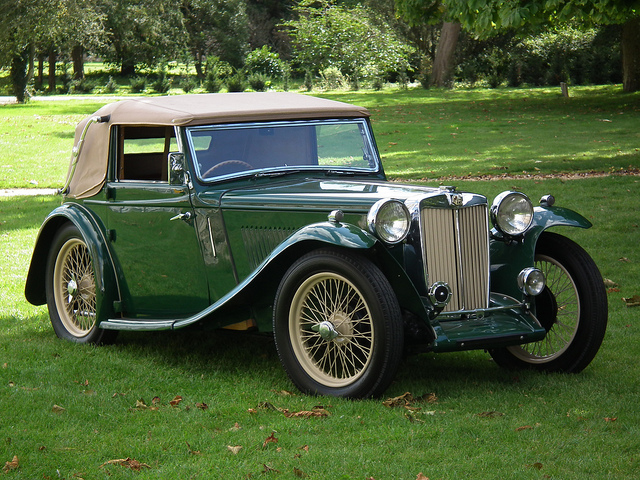
When the war started Billy Morris was sixty one but wanted to do something for his country. He was far too old to enlist although it is recorded that he did offer his services in 1940. He decided to form his own army of individuals who were not fit enough to join the regular services but were still able to do undertake such tasks as driving vehicles, manning searchlights, supplying and servicing stores, etc.
About 4,000 individuals volunteered to be part of Billy's private army including 120 women who were known as Billy's girls. He personally spent about fifty million dollars, (1940 dollars of course,) on creating this private arm of the regular services and was officially given the rank of full colonel by the War Dept. His uniform and photo still can be seen at the Heritage Center in the U.K... As he was about six foot four in his stocking feet it is quite an imposing picture. In 1945 the war ended and Morris was determined to get his factories back into peacetime production before any other British company.
The first MG rolled out of Abingdon factory on September 17th 1945, just one month after the war ended. By October all of his production plants were in full operation while no competitors had produced one 1945 vehicle for the private market. As the to be expected all the cars produced between 1945 and the close of 1946 were simply reproductions of prewar styles with a little touch of flair like headlights molded into the fenders which was the selling point of the post war Morris and Austin sedans. Ford introduced his first UK Postwar Vehicle in the spring of 1946, the Ford Pilot which was almost a duplicate of a 1938 Ford Family sedan sold in the USA. The only difference was the steering wheel was on the other side and the only color was black with no chrome fittings.
MG TC 1948
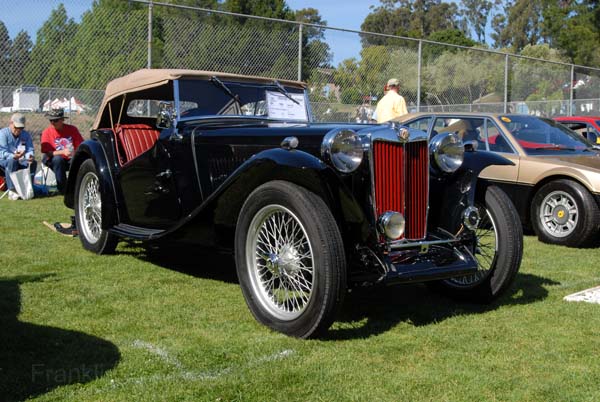
The MG post war style was the MGTC which was simply a MGTB with a four inch wide extension to the body to accommodate customers who expected some degree of physical comfort in their post war car. About 10,000 of these were produced and around 2,000 were sold in the USA from 1948 to 1949... In 1950 a completely new MG sports car was introduced, made for the US market and featuring such things as independent suspension, breaks that actually stopped the car and electrics that were reasonably reliable or to be more honest as reliable as any Lucas product could be...
Over 26,000 of these cars were produced between 1950 and 1953. That's more cars than the MG factory produced in all of its pre war years. On top of that MG started to make
a profit much to the delight of Billy Morris or to be more correct Lord Nuffield as he was now know. The TD was followed by a stop gap car the MGTF which was made to fill a production delay between the end of the TD and the introduction of the MGA which was based on the 1951 lemans MG entry.
MG TD 1952
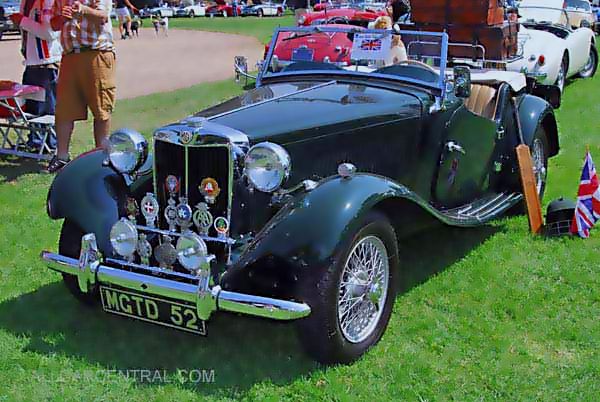
The MGA is a truly modern style that still looks attractive today. The final MG to come out of Abingdon was the MGB a style that lasted for seventeen years before the Thatcher Government closed the factory in 1980. This in turn was the start of the demise of the British Motor Industry which no longer exists but the dedication to the various breeds continues as any British gathering clearly shows that both sides of the Atlantic and around the world. If you doubt this may I suggest that you go to some country where no one speaks English. Smile and say MG with an accompaniment of a vocal imitation of a motor car. I bet the audience will smile and make similar noises and greet you like an old friend.
© 2013 Geoff Wheatley Contributing Reporter/Writer
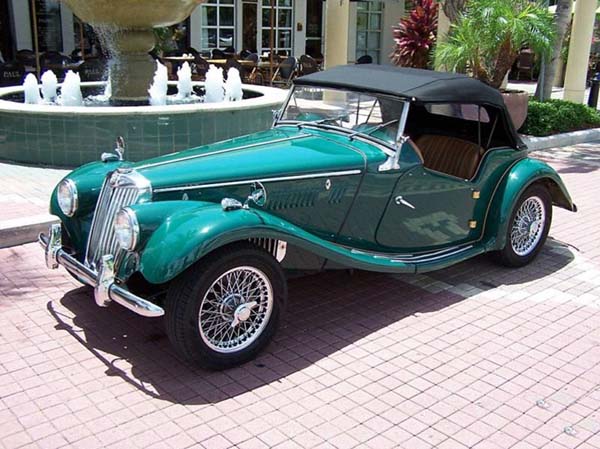
MGTF 1954
Photo Submitted by
Rick Feibusch, 2008
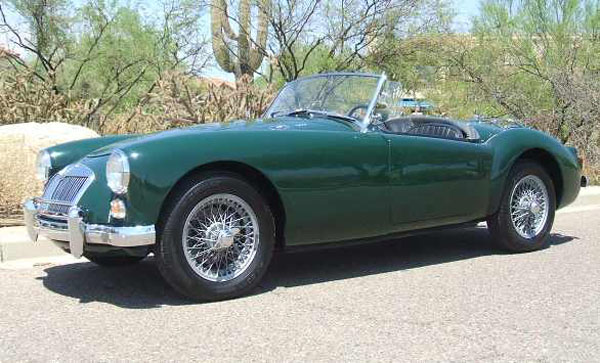
MGA 1960
Photo Submitted by
Rick Feibusch, 2008
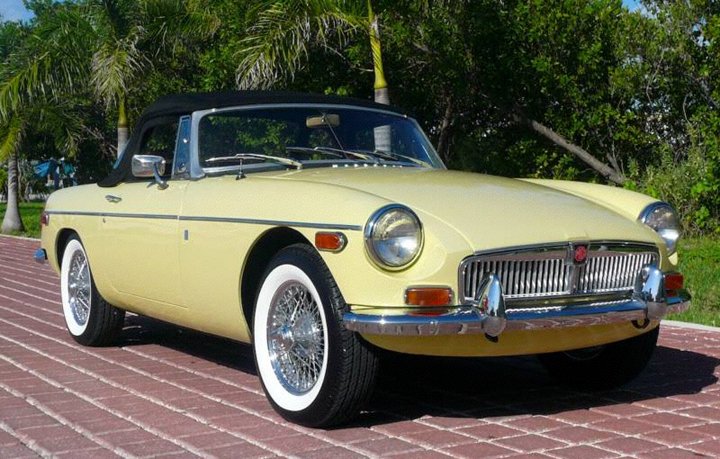
MGB 1969
Photo Submitted by
Rick Feibusch, 2012
|
|











